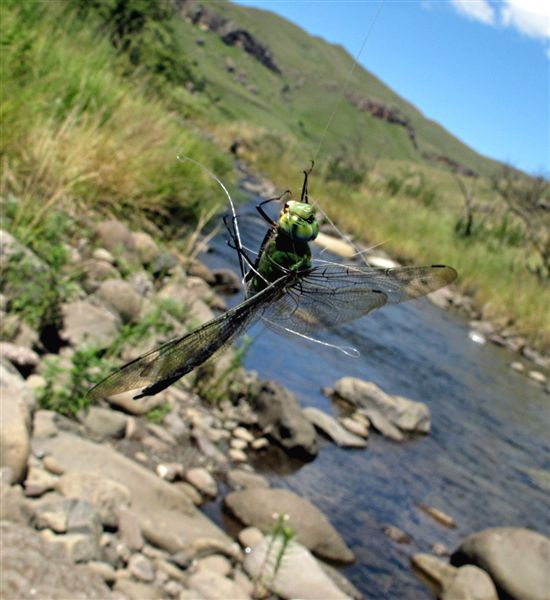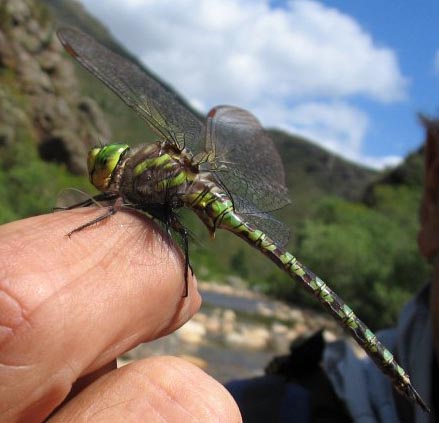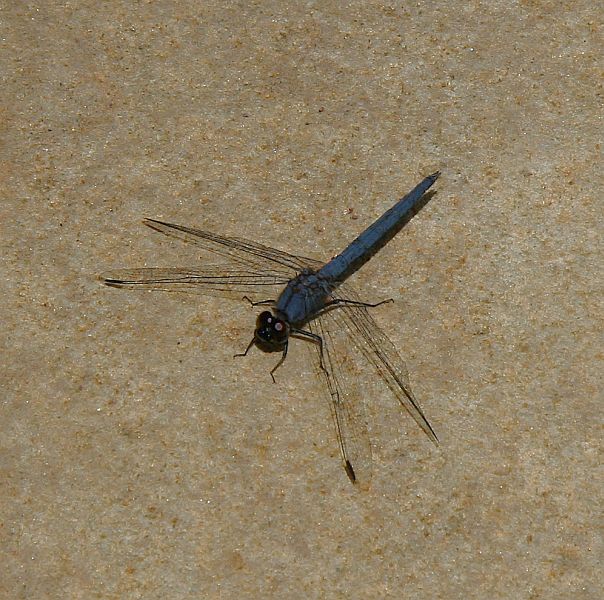DRAGONS ON DRY FLY
Pete Brigg sent me this piece with lovely images following a recent trip he made to the Bushman’s River in KZN:
I had a first yesterday. A large, approximately 8 to 10cm dragonfly took my fly out of the air in the cast, wouldn't let go and eventually became so tangled in the tippet there was no escape.


It was strong enough the keep the leader, tippet and fly up in the air until I managed to get hold of the leader and pull him down for a few photographs. Here are a few to visually relate the story, including the fly that fooled him and also a couple of Browns.

Pete Brigg's pattern that fooled a few trout and a dragonfly

I'm happy to report that all were successfully released with the help of Shaun Futter – dragonfly and brownies.
I have similar stories to relate and so does Ed Herbst.
I was fishing the Elandspad a year or three back with Ed Gerber when a dragonfly swooped on his Black Gnat in mid air and got itself tangled.

Dragonfly caught up on the Elandspad, Western Cape
Then more recently, Anthony Church and I had a similar experience, only this time the dragon pounced on the dry fly while it was in the drift then put up a fine aerial display before it got tangled in the tippet. Again, both dragons were released unharmed.

My son, Robert. Moments before he'd hooked a cow in paddock beyond the fence
Talking about hooking strange things, there was a story of someone once releasing a swallow on the Smalblaar but I’ve never been able to verify this.
Then I was present a year back when my son hooked a cow in the back leg. It was grazing behind a fence in a paddock adjacent the river Test in Hampshire. On 7X it broke him off smartly.
In Upstream, a Cape Town fly tackle shop, John Yelland showed me a video of an angler playing a fish from a float tube. Suddenly he discovers the ‘trout’ is actually a metre long puff adder. After that I noticed his back paddling became highly impressive!
But the pièce de résistance came from my old friend the late John Beams who told me he once hooked a moorhen fishing a pond in England at night. Apparently all hell broke loose but I’ll leave your imagination to work through the scene that followed.
For anyone interested in dragonflies – but more especially South African birds – here’s a site you will bless me for forever. Of its kind it’s the best in the business.
Ed Herbst responded to the dragonfly stories with this most interesting piece:
On the stream I fish the most, the Holsloot – which is about a 90 minute drive from Cape Town - dragonflies are prolific and they routinely dip down to examine your fly in flight. However, as the internet extracts (below) indicate, they have both exceptional flying agility and eyesight. As a result they usually bank away from the fly, obviously recognising that it is not prey.
However, on several occasions in the past thirty years, I have had them seize the fly and become entangled with it and the tippet. They are strong enough to remain in the air despite this encumbrance and I have just hand-lined them in and untangled them. They have always flown away, seemingly unharmed.
So prolific are they in the Holsloot area that South Africa’s leading dragonfly authority, Warwick Tarboton, makes an annual visit to stay at the cottages on Dwarsberg farm in the hopes of photographing some of the rarer species found there.
I believe trout are fully aware of the presence of dragonflies and can track them in the air. This, I believe, is why large Variants such as Tony Biggs’ RABs, with their slow, parachuting descent, are so successful on the small streams of the Western Cape
Internet documents sourced by Ed Herbst:
‘Dragonflies may be the best fliers on Earth. They can fly forward, backward and turn almost instantly. They can hover, turn while hovering and accelerate to full speed in a split second, then glide effortlessly’

A Navy Drop Wing photographed on the Holsloot River, Western Cape
‘Dragonflies are top-notch pilots. They not only fly fast, but also have excellent control over their manoeuvres in midair. When they jet along riverbanks or in wetland areas, they hold out their spiny legs in front to make little baskets for catching flying insects. They do not travel aimlessly, hoping an unlucky bug will somehow fly into their traps. Rather, they know exactly where to go. Dragonflies have two very big compound eyes, covering most of their heads. They see very well, so even the slightest movement will not escape them. As soon as they find a target, they track it down, scoop it up, and devour it. They complete the whole series of actions all while in flight!

A Stream Hawker drogonfly taken on the Holsloot River
‘Of course, dragonflies' swiftness and unique build for flight do not go unnoticed. Among all insects, they are the record holders of two titles. The first is for their speed. Dragonflies are the fastest flying insects in the world. As they beat their four long, membranous wings vigorously, they can accelerate up to 60 miles per hour! The second is for their bulging eyes. Dragonflies possess such large eyes that no other insects can even come close to try to challenge the claim. They have a field of vision nearly 360 degrees!’


